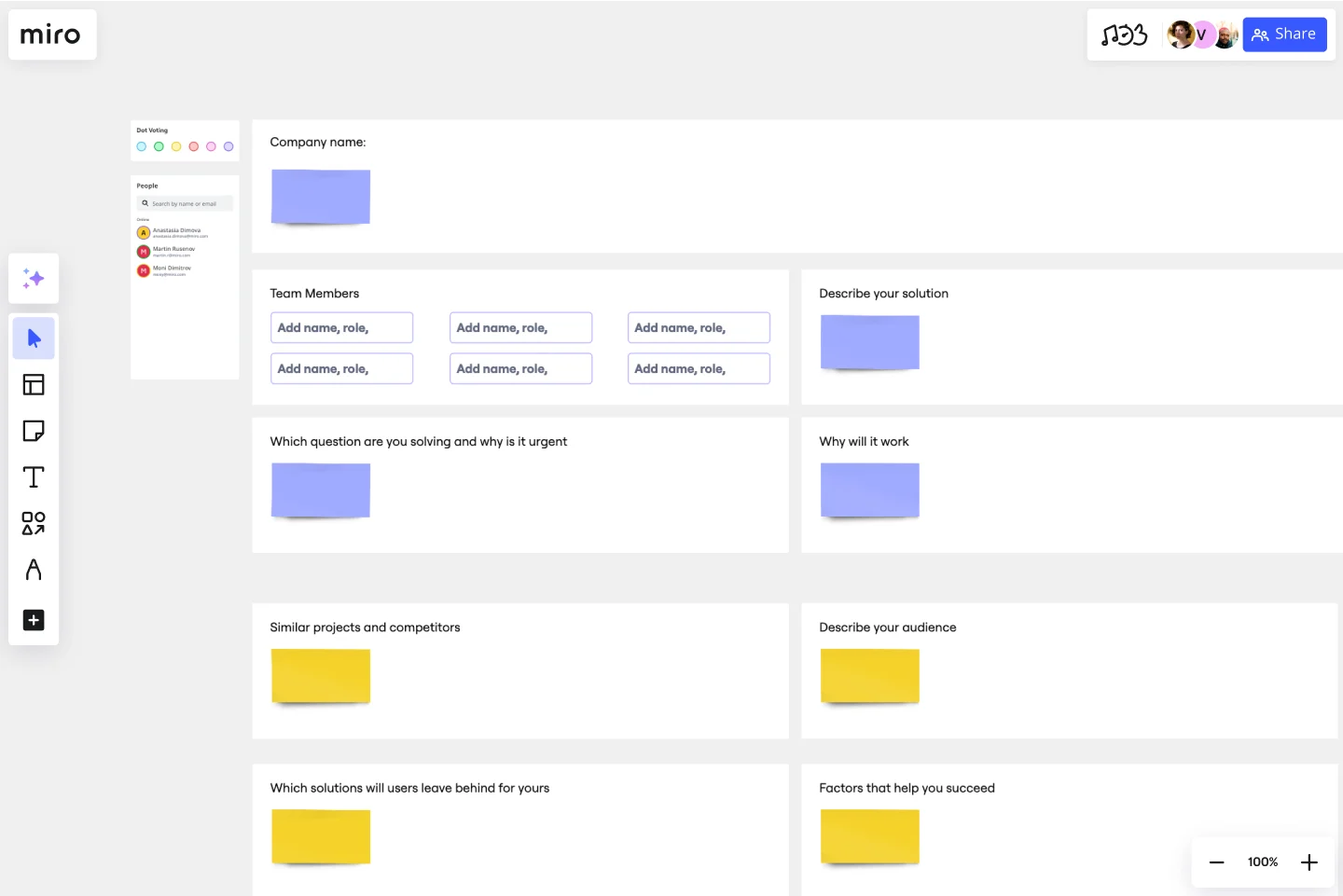Startup Canvas Template
Use this Idea Canvas Template as a useful visual map for founders who want to judge their new business idea's strengths and weaknesses. Share all your important start-up activities and information on just one single page.
About the Startup Canvas Template
Startup canvases are a useful visual map for founders who want to judge their new business idea’s strengths and weaknesses.
By articulating factors like success, viability, vision, and value to the customer, founders can make a concise case for why a new product or service should exist and get funded.
Need a canvas that helps you map out the profitability of your startup idea? That sounds like a Lean Canvas. If you have an existing business model you’d like to visualize, try out the Business Model Canvas.
What is a startup canvas?
A startup canvas helps founders express and map out a new business idea in a less formal format than a traditional business plan.
This canvas can be used as a framework to quickly articulate your business idea’s value proposition, problem, solution, market, team, marketing channels, customer segment, external risks, and key performance indicators.
Create your own startup canvas
Get started by selecting the startup canvas template, then take the following steps to make one of your own:
1. Name your business and confirm your team
Even if you haven’t registered a business name yet, the company name segment can be a space to brainstorm what you’ll call your new venture. Assemble the name of your dream team and on the details with you too.
2. Fill in each customer-related segment
From what your company stands for to your vision, values, each piece will help clarify your idea. Use each “statement” to start drafting key points based on understanding your customer’s key problems – and how your business idea offers a genuine solution.
3. Add at least two to three points for each customer-related segment
Each segment can contain at least three relevant ideas. For example, what are three market research insights or statistics that prove your business idea’s viability?
4. Check the confidence of your language
A startup canvas helps you turn broad ideas into a research-backed concept. Use clear, concise language instead of hedging statements (such as “but” or “however”). Your goal is to turn unaware investors into engaged business prospects.
5. Share the canvas with your team
After you’ve filled in all the segments, share the filled-in startup canvas template with team members or potential investors to get feedback and keep refining your business idea.
Get started with this template right now.
Sales Strategy Gantt Chart
Works best for:
Strategy, Planning
Creating and executing a sales strategy requires meticulous planning. The Sales Strategy Gantt Chart template helps you map out every step of your strategy, from goal setting to implementation and review. Visualize key activities, set timelines, and assign tasks to ensure your sales team stays focused and aligned. This template enables you to track progress, measure performance, and make data-driven adjustments for better sales outcomes.
Buyer Persona Template
Works best for:
Marketing, Desk Research, User Experience
You have an ideal customer: The group (or few groups) of people who will buy and love your product or service. But to reach that ideal customer, your entire team or company has to align on who that is. Buyer personas give you a simple but creative way to get that done. These semi-fictional representations of your current and potential customers can help you shape your product offering, weed out the “bad apples,” and tailor your marketing strategies for serious success.
Sprint Planning Template
Works best for:
Agile, Sprint Planning
The Sprint Planning Template is a useful tool for agile teams to organize and conduct sprint planning sessions. It enhances team collaboration and communication by providing a clear visual layout of sprint goals, tasks, and timelines. The interactive design ensures team alignment toward sprint objectives, leading to effective teamwork. The template is a central hub for planning, discussion, and decision-making, creating a collaborative and productive environment.
Fishbone Diagram for Marketing
Works best for:
Fishbone diagram
Identifying the root causes of marketing challenges is essential for effective strategy development. The Fishbone Diagram for Marketing template helps you systematically explore factors affecting your marketing efforts. Categorize potential causes into areas such as market research, product positioning, promotional strategies, and distribution channels. This structured analysis enables your team to pinpoint and address issues, optimizing marketing campaigns.
Sprint Planning with Jira Template
Works best for:
Sprint Planning, Agile
The Sprint Planning with Jira template in Miro is a powerful tool designed to streamline and enhance your sprint planning sessions. One of the key benefits of this template is its Jira integration, which saves time and effort when planning and aligning teams. By integrating directly with Jira, the template allows for seamless import and management of tasks, ensuring that all your Jira tickets are up-to-date and easily accessible within Miro. This reduces the need for manual updates and minimizes errors, making the planning process more efficient and effective.
Starfish Retrospective
Works best for:
Retrospectives, Agile Methodology, Meetings
The Starfish Retrospective template offers a structured approach to retrospectives using the metaphor of a starfish. It provides elements for identifying what to start, stop, continue, do more of, and do less of. This template enables teams to reflect on past iterations, identify actionable insights, and prioritize improvements. By promoting clarity and focus, the Starfish Retrospective empowers teams to drive meaningful change and continuous improvement effectively.
